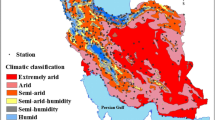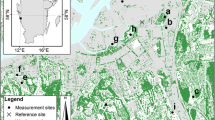Summary
The influence of desert-fringe vegetation on the daytime sensible heat flux is examined. The calculations are based on a previously developed surface albedo model for the plants/soil surface and the soil heat flux observational data for both bare and vegetated areas. It is found that the sensible heat flux from an ecosystem in a fenced-off area (exclosure) in the Sinai is larger than that from bare soil (overgrazed areas outside the exclosure) by a factor of 1.5 to 2.0, depending on the solar zenith angle. The contributions to this enhanced flux from the albedo reduction and the soil heat flux reduction are of the same magnitude.
Various studies have established that a larger heat flux increases daytime convection and boundary layer growth, and thus an enhanced flux increases the probabilities for precipitation even in a parched region when moisture is advected from outside. The results of this investigation therefore suggest that removal of desert-fringe vegetation can reduce precipitation and promote drought.
Zusammenfassung
Es wird der Einfluß der Vegetation am Rande der Wüste auf den tagsüber fühlbaren Wärmefluß untersucht. Die Rechnungen basieren auf einem früher entwickelten Modell für die Oberflächenalbedo der Pflanzen-/Erdoberfläche und auf Meßwerten für den Wärmefluß von vegetationslosen und bewachsenen Flächen. Wir finden, daß der fühlbare Wärmefluß eines abgezäunten Ökosystems in der Sinai um einen Faktor 1,5 bis 2,0 größer ist (abhängig vom Sonnenstand) als der Wärmefluß von einer unbewachsenen, abgegrasten Fläche außerhalb der Einzäunung. Die Beiträge zu diesem verstärkten Fluß kommen zu gleichen Teilen von der Reduktion der Albedo und des Wärmeflusses in den Erdboden.
Mehrere Studien haben gezeigt, daß ein größerer Wärmefluß die Konvektion am Tage verstärkt, zu einer höheren Grenzschicht führt und daß deshalb ein verstärkter Wärmefluß eine Zunahme der Niederschlagswahrscheinlichkeit sogar in ausgetrockneten Gebieten bewirkt, wenn die Feuchtigkeit von außen durch Advektion zugeführt wird. Das Ergebnis dieser Untersuchung zeigt, daß die Vernichtung von Vegetation am Rande der Wüste zu einer Verringerung der Niederschläge führen kann und die Austrocknung gefördert wird.
Similar content being viewed by others
References
Berkofsky, L., 1977: The relation between surface albedo and vertical velocity in a desert.Beitr Phys Atmos. 50, 312–320.
Black, J. F., Tarmy, B. L., 1963: The use of asphalt coatings to increase rainfall.J. Appl. Meteor. 2, 557–564.
Brunt, D., 1932: Notes on radiation in the atmosphere (I.).Quart. J. Roy. Meteor. Soc. 58, 389–418.
Charney, J. G., 1975: Dynamics of deserts and drought in the Sahel.Quart J. Roy. Meteor. Soc. 101, 193–202.
Clothier, B. E., Clawson, K. L., Pinter Jr., P. J., Moran, M. S., Reginato, R. J., Jackson, R. D., 1986: Estimation of soil heat flux from net radiation during the growth of alfalfa.Agric Forest Meteor. 37, 319–329.
Federer, C. A., 1968: Spatial variation of net radiation, albedo and surface temperature of forests.J. Appl. Meteor. 7, 789–795.
Fuchs, M., Hadas, A., 1972: The heat flux density in a nonhomogeneous bare loessial soil.Bound. Layer Meteor. 3, 191–200.
Hillel, D., 1980:The Fundamentals of Soil Physics. New York: Academic Press, 413 pp.
Idso, S. B., Aase, J. K., Jackson, R. D., 1975: Net radiation—soil heat flux relations as influenced by soil water content variations,Bound. Layer Meteor. 9, 113–122.
Jackson, R. D., Idso, S. B., 1975: Surface albedo and desertification.Science 189, 1012–1013.
Kutiel, H, 1977: The distribution of rainfall by intensity in Israel (in Hebrew). M. Sc. Thesis, Department of Geography, Hebrew University Jerusalem, Israel.
Lettau, H. H., 1969: Note on aerodynamic roughness—parameter estimation on the basis of roughness—element description.J. Appl. Meteor. 8, 828–832.
Malkus, J. S., 1963: Tropical rain induced by small natural heat source.J. Appl. Meteor. 2, 547–556.
McGarry, M. M., Reed, R. J., 1978: Diurnal variations in convective activity and precipitation during Phases II and III of Gate,Mon. Wea. Rev. 106, 101–113.
Nicholson, S. E., 1979: Climatic variations in the Sahel and other African regions during the past five centuries.J. Arid Environments 1, 3–24.
Otterman, J., 1974: Baring high—albedo soils by overgrazing: a hypothesized desertification mechanism.Science 186, 531–533.
Otterman, J., 1978: Single—scattering solution for radiative transfer through a turbid atmosphere.Appl. Opt. 17, 3431–3438.
Otterman, J., 1981a: Plane with protrusions as an atmospheric boundary.J. Geophys. Res. 86, 6627–6630.
Otterman, J., 1981b: Satellite and field studies of man's impact on the surface of arid regions.Tellus 33, 68–77.
Otterman, J., Sharon, D., 1979: Day/night partitioning of rain in an arid region: computational approaches, results for the Negev, and meteorological/climatological implications.J. Rech. Atmos. 13, 11–20.
Otterman, J, Robinove, C. J., 1982: Landsat monitoring of desert vegetation growth, 1972–1979, using a plant shadowing models.Advances in Space Research 2, 45–50.
Otterman, J., Tucker, C. J., 1985: Satellite measurements of surface albedo and temperatures in semi desert.J. Climate Appl. Meteor. 24, 228–235.
Otterman, J., Deering, D., Eck, T., Ringrose, S., 1987: Techniques of ground-truth measurements of desert-scrub structure.Advances in Space Research,7, 153–158.
Shaia, J. S., Jaffe, S., 1976: Midday inversions over Bet Bagan, Series A Meteorological Notes #33, Israel Meteorological Service, Bet Dagan, Israel.
Sharon, D., 1972: The spottiness of rainfall in a desert area.J. Hydrol. 7, 161–175.
Swinbank, W. C., 1963: Longwave radiation from clear skies.Quart. J. Roy. Meteor. Soc. 89, 339–348.
Thalen, D. C. P., 1979:Ecology and Utilization of Desert Shrub Rangelands in Iraq The Hague: Dr. W. Junk B. V. Publishers, 448 pp.
Waisel, Y. 1986: Interactions among plants, man and climate: historical evidence from Israel. Proceedings of the Royal Society of Edinburgh, 89B, 255–264.
Author information
Authors and Affiliations
Additional information
With 2 Figures
Rights and permissions
About this article
Cite this article
Otterman, J. Enhancement of surface-atmosphere fluxes by desert-fringe vegetation through reduction of surface albedo and of soil heat flux. Theor Appl Climatol 40, 67–79 (1989). https://doi.org/10.1007/BF00867793
Received:
Revised:
Issue Date:
DOI: https://doi.org/10.1007/BF00867793




